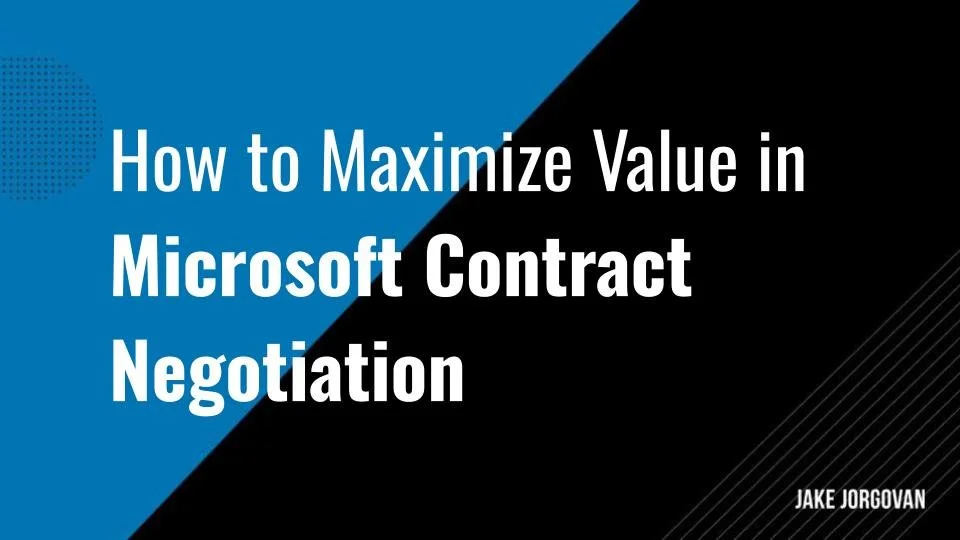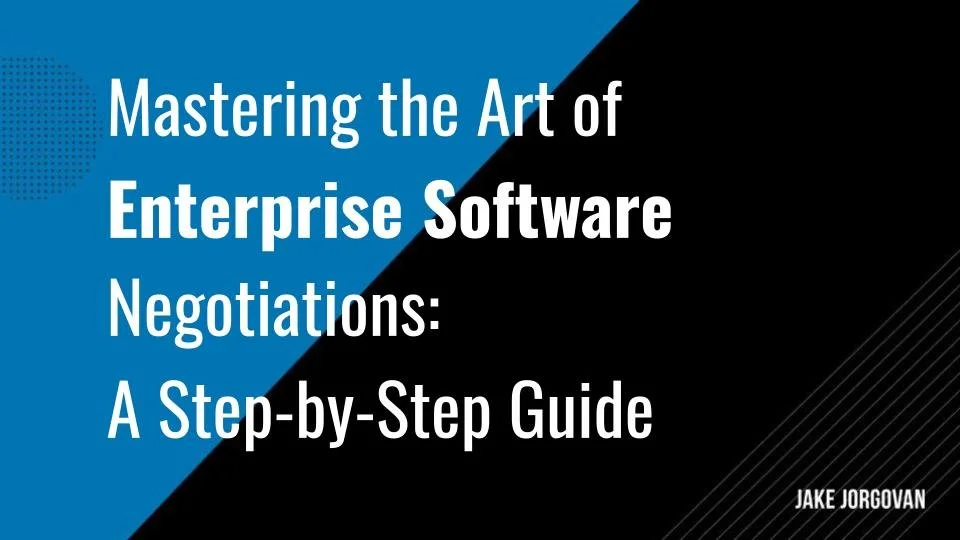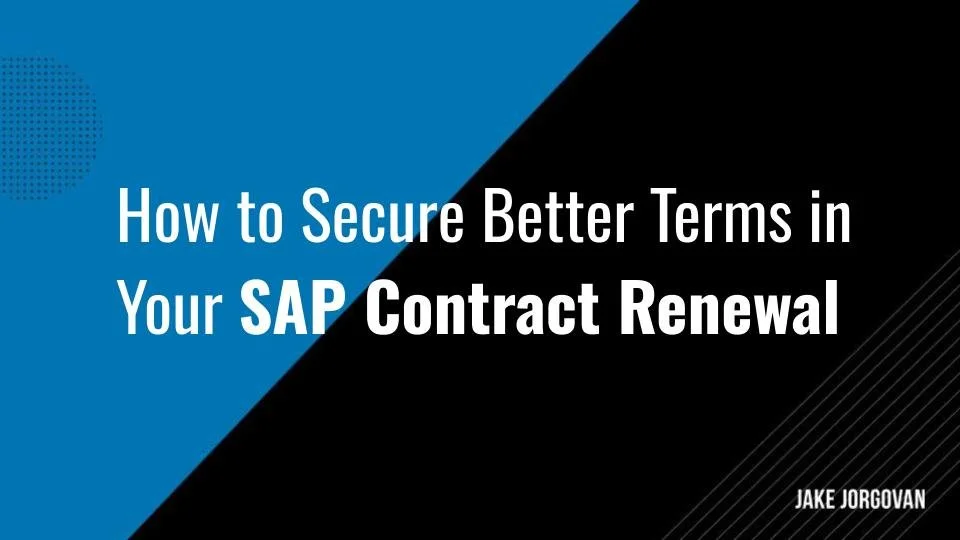Leveraging Technology to Find Cost Savings During Enterprise Contract Negotiations: 5 Essential Strategies
Negotiating enterprise contracts can be complex and costly.
If you get this process wrong, you’ll pay for it — studies indicate that an average of 9.2% of annual revenue is lost due to contract mismanagement, with larger companies experiencing losses of up to 15%.
However, technology offers new ways to streamline this process and beef up your negotiation capabilities. In doing so, the right tools can uncover significant cost savings.
This article explores 5 essential strategies to optimize contract negotiations through technology.
Learn how to harness data analytics, AI, and other innovations to build successful partnerships with vendors and save money at the same time.
The Importance of Leveraging Technology for Enterprise Contract Negotiations
Technology, when used correctly, can completely transform the way businesses approach the art of negotiation. Check out a few of the benefits in the following graphic:
Leveraging technology in enterprise contract negotiations is crucial for optimizing outcomes and achieving cost savings. Advanced tools provide significant advantages that streamline the negotiation process and improve decision-making.
Data-driven insights are essential. Analytical tools process vast amounts of data to identify trends and patterns. These insights allow you to make informed decisions and strengthen your negotiation position. With accurate data at your fingertips, you can manage more effective negotiations and secure better terms.
Efficiency improvements are another key benefit. Automated tools handle repetitive tasks, reducing manual effort and minimizing errors. This allows your negotiation team to focus on strategic aspects of the negotiation. Automation also accelerates the process, leads to faster deal closures, and reduces administrative overhead.
Technology also enhances risk management. Automated compliance checks and risk assessment tools identify potential issues early. This proactive approach helps mitigate risks and avoid costly disputes. Compliance with regulations and internal policies becomes much more manageable.
Additionally, technology supports scalability. Automated systems can handle increased volumes as your business grows without compromising efficiency. This scalability ensures that your negotiation processes remain robust and effective even as your operations expand.
5 Essential Strategies for Leveraging Technology During Enterprise Contract Negotiations
1) Utilize Contract Management Software
Using contract management software can help your negotiation team find cost savings during enterprise contract negotiations. This tool streamlines the process, reduces errors, and provides valuable insights. In the graphic below, you can see some of the most important factors to consider when choosing your contract management software.
Here’s how you can utilize contract management software:
Centralize contract storage: Store all contracts in a single, secure repository. This ensures easy access and prevents the loss of important documents.
Automate workflows: Implement automated workflows to manage contract negotiation tasks like contract creation, approval, and renewal. The point is to reduce manual effort and accelerate the negotiation process. Using the right contract management software can cut contract approval time by 82%.
Track key metrics: Use the software to monitor contract performance metrics such as compliance rates, contract value, and renewal dates. These insights help identify areas for cost savings.
Standardize templates: Develop and utilize standardized contract templates. That’s how you ensure consistency and reduce the time needed to draft new contracts.
Enhance collaboration: Enable real-time collaboration among stakeholders through the software. This improves communication and speeds up decision-making.
Audit trails: Maintain detailed audit trails of all contract activities. This provides transparency and helps identify inefficiencies.
Integrate with other systems: Ensure the software integrates with your existing ERP, CRM, and procurement systems. This integration enhances data accuracy and provides a holistic view of contract-related activities.
2) Implement E-Signature Solutions
The global e-signature market is growing fast and is expected to be worth $34.8 billion by 2028.
E-signature solutions, such as DocuSign, Adobe Acrobat Sign, and DropboxSign, are vital to your contract negotiation success. They streamline the signing process, reduce turnaround time, and cut costs.
To effectively implement e-signature solutions, a good first step is to choose an e-signature solution that complies with legal standards and integrates well with your existing systems. This measure is for extra security and compatibility.
Then, create accounts for all stakeholders involved in the contract process. That’s useful for seamless coordination and access. Store your standardized contract templates within the e-signature platform. This saves time when drafting new contracts and ensures consistency.
Next, define and automate the signing order based on your organizational needs. This step ensures that your contracts are routed to the right people in the correct sequence. Use robust authentication methods like multi-factor authentication to verify the identities of signers. The point here is to add an extra layer of security.
Remember to monitor the progress of each contract in real-time, as this helps identify bottlenecks and ensures timely follow-ups. Automatically store signed contracts in a secure, searchable database. This step simplifies retrieval for future reference and audits.
Finally, you should regularly review your e-signature processes to ensure they comply with relevant laws and regulations. This way, you protect your organization from legal risks.
3) Leverage Data Analytics for Spend Analysis
Utilizing data analytics for spending analysis is a powerful strategy for finding cost savings during business negotiations. This approach helps you uncover spending patterns and identify areas where you can negotiate better terms. Here are a few of the main advantages:
Here’s how to leverage data analytics for spend analysis:
Gather comprehensive data: Collect all relevant spending data from various sources, such as invoices, purchase orders, and contracts. You want to have a complete picture of your expenditures.
Clean and organize data: Ensure the data is accurate and well-organized. Remove duplicates and correct any errors to maintain data integrity.
Classify spending categories: Categorize spending into relevant groups, such as direct and indirect spending, categories, suppliers, and departments. This helps identify specific areas for cost savings.
Analyze historical spend: Examine past spending patterns to identify trends and anomalies. Look for opportunities to consolidate spending with fewer suppliers to negotiate better terms.
Identify cost drivers: Determine the key factors driving your costs. You could include supplier pricing, order quantities, or contract terms.
Benchmark against industry standards: Compare your spending patterns with industry benchmarks. This approach will help you understand whether you are overpaying compared to your peers.
Leverage predictive analytics: Use predictive analytics to forecast future spending based on historical data. This software allows you to address potential cost increases proactively.
Generate actionable insights: Translate your analysis into actionable insights. Identify specific suppliers or categories where you can negotiate better terms or switch to alternative suppliers.
Insider Tip:
Update your spending analysis regularly with the latest data. The point is to keep your insights relevant so that you can continuously find new cost-saving opportunities. We recommend setting up automated data feeds to keep your analysis current and accurate. This enables you to react quickly to any changes in spending patterns.
4) Use Automated Compliance Tracking
Automated compliance tracking helps your contracts meet regulatory standards and internal policies. In fact, research shows that companies with best-in-class contract management are almost three times as likely to have compliant contracts.
This process allows you to avoid costly penalties and maintain consistency. You can see some of the main benefits here:
Here’s how you can implement automated compliance tracking effectively:
To begin, choose a compliance tracking tool, such as ContractWorks, Icertis Contract Intelligence, or Agiloft, that integrates seamlessly with your existing contract management system. A solid software solution ensures smooth data flow and reduces manual efforts.
Clearly outline all regulatory and internal compliance requirements relevant to your contracts. This forms the basis for setting up automated checks.
Next, configure the software to send alerts for key compliance events, such as contract renewals, expirations, or deviations from standard terms. You’re doing this because you want timely actions.
Connect your compliance tool with up-to-date legal and regulatory databases to ensure your compliance checks reflect the latest standards. Create automated approval workflows that route contracts to the appropriate stakeholders based on compliance requirements. That way, you get thorough reviews without delays.
It’s also important to use real-time dashboards to monitor the compliance status of all contracts. This provides instant visibility into potential issues. Schedule periodic automated audits to review compliance status across all contracts. This step is important because it helps you identify and rectify any lapses and minimize contract risk.
Don’t forget to use the software to generate detailed compliance reports. These reports provide insights into compliance trends and areas needing improvement.
Additionally, you should customize your compliance tracking tool to flag high-risk contracts for additional scrutiny. We suggest creating risk profiles based on factors such as contract value and supplier history. This proactive approach helps mitigate risks early and ensures robust compliance management.
5) Integrate AI-Driven Negotiation Tools
Artificial intelligence has a huge role to play in the contract management process. In the graphic below, you can see some of the main benefits this technology offers.
Using AI-based negotiation technologies can take you much closer to contract negotiation success. These tools provide data-driven insights, streamline communications, and help secure better terms. AI models identify potential risks, compliance issues, and inconsistencies with precision, reducing errors in contract negotiations.
To implement AI-driven negotiation tools effectively, start by selecting a tool, such as Kira Systems, Lexion, and Evisort, that aligns with your needs and integrates seamlessly with your existing systems, ensuring smooth adoption and operations.
Next, train the AI model by feeding it historical contract data. This step enables the AI to recognize your negotiation patterns and pinpoint areas for improvement. Once the tool is in place, it’s essential to identify key metrics that align with your goals. These may include KPIs such as contract value, negotiation time, and overall savings achieved.
After establishing your metrics, configure the tool to provide real-time suggestions during negotiations. These suggestions might include alternative terms, pricing adjustments, or risk assessments that can strengthen your position. As negotiations progress, monitor performance using the AI tool’s dashboard to track ongoing discussions and flag any potential issues. Additionally, leverage the AI’s ability to analyze competitor data, if available. Benchmarking your contracts against industry standards can highlight opportunities for improvement and give you a competitive edge.
AI analytics also offers valuable insights into supplier performance based on historical contracts. By evaluating supplier outcomes, you can negotiate better terms with top-performing suppliers, optimizing your agreements over time.
Finally, continuously refine your negotiation strategies using the AI’s data-driven insights. This iterative approach allows you to adapt to changing conditions and remain competitive in a dynamic market.
“AI-powered contract negotiation tools streamline and optimize vendor negotiations, delivering unmatched efficiency, accuracy, and data-driven insights.” - Cimphony
Common Mistakes When Using Technology to Save Costs During Contract Negotiation
Relying solely on automated tools without oversight
Mistake: Many organizations over-rely on contract negotiation software tools or AI solutions without involving human expertise. This can result in missed nuances, overlooked clauses, lack of emotional intelligence, or inappropriate risk assessments.
Solution: Use technology as a complement to human negotiators with contract negotiation skills. Implement regular human reviews throughout the negotiation process to validate critical decisions and ensure contracts align with business objectives.
Failing to integrate technology with existing systems
Mistake: Enterprises sometimes adopt new contract management solutions without ensuring compatibility with current procurement, legal, or finance systems, leading to inefficiencies.
Solution: Choose tools that integrate seamlessly with your existing tech stack. Conduct integration testing and provide training to stakeholders to streamline adoption.
Overlooking data insights for contract negotiation strategy
Mistake: Many organizations fail to leverage data insights from technology to inform their negotiation strategies, instead relying on outdated tactics.
Solution: Use analytics tools to assess historical data, vendor performance, and market trends. Base negotiation decisions on actionable insights derived from these analyses. This can help you plan future negotiations with much more confidence.
Ignoring vendor-specific requirements or customizations
Mistake: Using generic templates or processes in technology-driven negotiations overlooks vendor-specific nuances, which can lead to unfavorable terms.
Solution: Customize contract templates and negotiation workflows for each vendor. Use contract lifecycle management tools that allow flexibility while ensuring compliance with organizational policies.
Underestimating change management needs
Mistake: Deploying new technology without addressing change management challenges often results in poor adoption and inconsistent use.
Solution: Develop a comprehensive change management plan. Provide training, clear guidelines, and ongoing support to ensure the successful implementation of new tools and practices.
These common mistakes, if left unaddressed, can undermine the cost-saving potential of technology. Tackling them proactively ensures that technology improves, rather than hinders, your negotiation capabilities.
Take Control of Enterprise Contract Negotiations with Technology
Embracing technology in contract negotiations is no longer optional. It's a strategic imperative.
Each tool and strategy discussed can transform your approach and drive significant cost savings, giving you advanced negotiation superpowers.
Stay proactive and leverage these innovations to transform your approach to negotiation planning, secure better contracts, and redefine your future negotiations.
Frequently Asked Questions
How does technology affect negotiation?
Technology streamlines communication, enhances data analysis, and provides tools for real-time collaboration. This leads to more data-driven and effective negotiations.
What is a common mistake while negotiating?
Failing to prepare adequately or understand the other party's needs often leads to missed opportunities and unfavorable outcomes.
What are some of the best negotiation tools?
Popular tools include DocuSign for e-signatures, Slack for collaboration, and CRM platforms like Salesforce to track deal progress.
How can AI be useful in negotiations?
AI helps analyze large data sets, predict outcomes, gain strategic insights, and suggest optimal strategies, enabling more informed and objective decision-making and leading to more successful negotiations.
What is contract management software?
Contract management software automates the creation, storage, and tracking of contracts. This leads to more negotiations by ensuring compliance and improving efficiency throughout the contract lifecycle.
































